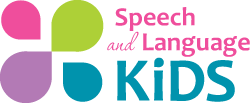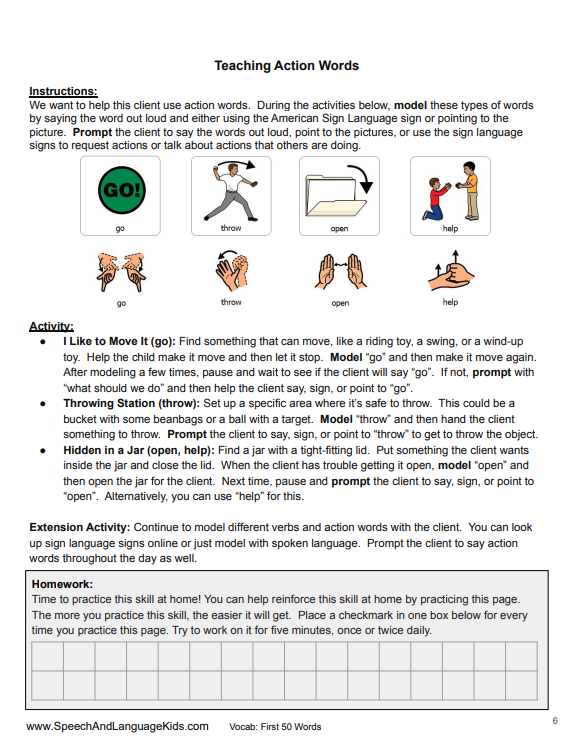1-Year-Old Speech Milestones:
The following skills are all expected to emerge by or around 1 year of age. Not all children will acquire all of these skills by this age. If a child is missing a few skills, we generally don’t worry too much. However, if a child is far off from many of these skills, we like to get them in for a speech/language assessment/evaluation.
This page is recommended as a general guide to give you an ideas of skills you could address within this age bracket. It is not meant to diagnose a child or provide treatment recommendations. SLK Hub is for informational and educational purposes only and does not provide medical or psychological advice.
* To view the sources for this information, please scroll to the bottom.
1-Year-Old Speech Milestones (Sound Production)
- Babbles longer strings of sounds, like mimi, upup, bababa
- Imitates some speech sounds or will take turns “talking” with an adult (even if not using real words)
1-Year-Old Language Milestones
When we look at 1-year-old language milestones, we are looking at how a child is using words and putting those words together to communicate with those around them. A lot goes into language skills. Here is a checklist of the 1-year-old language milestones:
- Says 1 or 2 words around first birthday, such as “hi”, “dog”, “dada”, “mama”, or “uh-oh”
(It’s ok if it takes a little longer. We like to see that first word happen by 15 months!) - Recognizes words for familiar objects and people
- Begins to respond to simple words and phrases, such as “no” and “come here”
1-Year-Old Social Skill/Interaction Milestones
Another aspect of 1-year-old speech milestones is how well they can interact with others. Here are some milestones related to social skills and interaction.
- Plays games with you, like pat-a-cake and peek-a-boo
- Uses gestures such as waving, reaching, or shaking head “no”
- Turns and looks in direction of sounds and voices
- Looks when you point or look where you are looking
- Turns to own name when you call
- Listens to songs and stories for a short time
- Points to objects and shows them to others
- Smiles back at caregiver
- Vocalizes to get attention
- Seeks a caregiver for comfort, help, and play; may fear strangers
For more resources on teaching social skills to children, click here.
Activities and Ideas for Boosting Language Skills in 1-Year-Olds:
If you are looking for therapy ideas or home activities to boost a child’s language skills, check out our premade activities and training courses inside The Hub:

About the Author: Carrie Clark, MA CCC-SLP
Hi, I’m Carrie! I’m a speech-language pathologist from Columbia, Missouri, USA. I’ve worked with children and teenagers of all ages in schools, preschools, and even my own private practice. I love digging through the research on speech and language topics and breaking it down into step-by-step plans for my followers.
Fun Fact: When my son was three, he once got mad at me and told me he was going to send me to Antarctica in nothing but a t-shirt. He had an overly large vocabulary for a 3-year-old….along with an overly large amount of sass. He still has both to this day.
Connect with Me:
Sources:
The following sources were used to provide the ages, skills, and milestones on this page. Keep in mind that different studies have found different results. We have tried selecting more recent studies and using information provided by reputable sources such as the American Speech-Language Hearing Association and the Center for Disease Control. However, we understand that there are other studies out there that may contradict this information somewhat.
Please use these resources as a general guide and use your own professional judgement as well. Parents should seek the advice of a licensed speech-language pathologist who can sort through this information and make recommendations based on a specific child’s situation and needs.
Speech Sound Intelligibility:
Hustad, Katherine C., et al. “Speech Development Between 30 and 119 Months in Typical Children I: Intelligibility Growth Curves for Single-Word and Multiword Productions.” 2021, https://pubs.asha.org/doi/10.1044/2021_JSLHR-21-00142. Accessed 30 Oct. 2023.
Speech Sound Age of Acquisition:
Crowe, Kathryn, and Sharynne McLeod. “Children’s English Consonant Acquisition in the United States: A Review.” 2020, https://pubs.asha.org/doi/10.1044/2020_AJSLP-19-00168. Accessed 30 Oct. 2023.
Speech Sound Development Page on ASHA Website:
“Speech Sound Disorders.” American Speech-Language-Hearing Association, American Speech-Language-Hearing Association, www.asha.org/public/speech/disorders/speech-sound-disorders/. Accessed 30 Oct. 2023.
ASHA’s Communicating with Baby Tips and Milestones Fliers:
“Communicating with Baby: Tips and Milestones from Birth to Age 5.” Identify The Signs, American Speech-Language Hearing Association, 20 Nov. 2017, https://identifythesigns.org/communicating-with-baby-toolkit/.
CDC’s Developmental Milestones:
“CDC’s Developmental Milestones.” Centers for Disease Control and Prevention, Centers for Disease Control and Prevention, 6 June 2023, www.cdc.gov/ncbddd/actearly/milestones/index.html.
ASHA’s Social Communication Benchmarks:
“Social Communication Benchmarks.” American Speech-Language-Hearing Association, American Speech-Language-Hearing Association, www.asha.org/practice-portal/clinical-topics/social-communication-disorder/social-communication-benchmarks/. Accessed 30 Oct. 2023.
ASHA’s Phonological Processes/Patterns Age of Elimination:
“Selected Phonological Processes.” American Speech-Language-Hearing Association, American Speech-Language-Hearing Association, www.asha.org/practice-portal/clinical-topics/articulation-and-phonology/selected-phonological-processes/. Accessed 30 Oct. 2023.
Mean Length of Utterance/Average Sentence Length:
Rice, Mabel L., et al. “Mean Length of Utterance Levels in 6-month Intervals for Children 3 to 9 Years with and Without Language Impairments.” Journal of Speech, Language, and Hearing Research : JSLHR, vol. 53, no. 2, 2010, p. 333, https://www.ncbi.nlm.nih.gov/pmc/articles/PMC2849178/ (2009/08-0183). Accessed 30 Oct. 2023.
Brown’s Stages of Morphology:
Bowen, Caroline. “Brown’s Stages of Syntactic and Morphological Development.” Brown’s Stages of Syntactic and Morphological Development, 9 Nov. 2011, https://www.speech-language-therapy.com/index.php?option=com_content&view=article&id=33:brown&catid=2:uncategorised&Itemid=117..
Pronoun Acquisition:
Vollmer, Erin. “Pronoun Acquisition: Child Development.” TherapyWorks, 2 Feb. 2023, https://therapyworks.com/blog/language-development/speech-strategies/pronoun-acquisition/.
Developmental Stages of Social Emotional Development in Children:
Malik F, Marwaha R. Developmental Stages of Social Emotional Development in Children. [Updated 2022 Sep 18]. In: StatPearls [Internet]. Treasure Island (FL): StatPearls Publishing; 2023 Jan-. Available from: https://www.ncbi.nlm.nih.gov/books/NBK534819/







This straightforward list is super helpful, thank you!